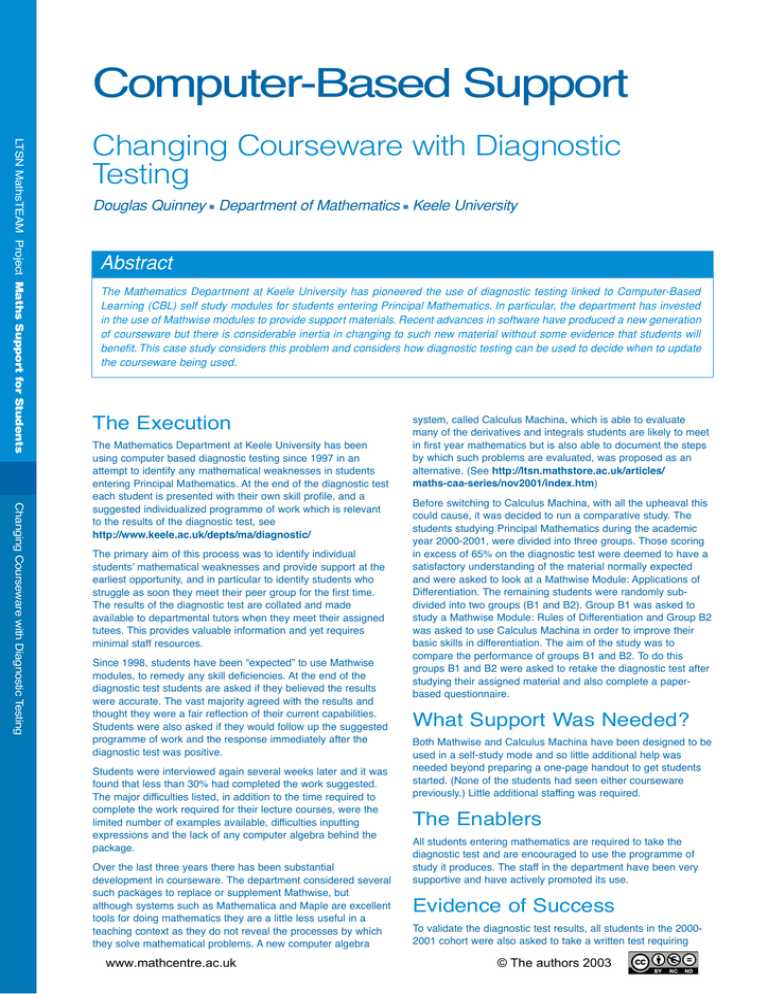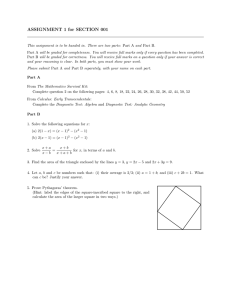Computer-Based Support Abstract
advertisement

Computer-Based Support LTSN MathsTEAM Project Maths Support for Students Changing Courseware with Diagnostic Testing Douglas Quinney ■ Department of Mathematics ■ Keele University Abstract The Mathematics Department at Keele University has pioneered the use of diagnostic testing linked to Computer-Based Learning (CBL) self study modules for students entering Principal Mathematics. In particular, the department has invested in the use of Mathwise modules to provide support materials. Recent advances in software have produced a new generation of courseware but there is considerable inertia in changing to such new material without some evidence that students will benefit. This case study considers this problem and considers how diagnostic testing can be used to decide when to update the courseware being used. The Execution Changing Courseware with Diagnostic Testing The Mathematics Department at Keele University has been using computer based diagnostic testing since 1997 in an attempt to identify any mathematical weaknesses in students entering Principal Mathematics. At the end of the diagnostic test each student is presented with their own skill profile, and a suggested individualized programme of work which is relevant to the results of the diagnostic test, see http://www.keele.ac.uk/depts/ma/diagnostic/ The primary aim of this process was to identify individual students’ mathematical weaknesses and provide support at the earliest opportunity, and in particular to identify students who struggle as soon they meet their peer group for the first time. The results of the diagnostic test are collated and made available to departmental tutors when they meet their assigned tutees. This provides valuable information and yet requires minimal staff resources. Since 1998, students have been “expected” to use Mathwise modules, to remedy any skill deficiencies. At the end of the diagnostic test students are asked if they believed the results were accurate. The vast majority agreed with the results and thought they were a fair reflection of their current capabilities. Students were also asked if they would follow up the suggested programme of work and the response immediately after the diagnostic test was positive. Students were interviewed again several weeks later and it was found that less than 30% had completed the work suggested. The major difficulties listed, in addition to the time required to complete the work required for their lecture courses, were the limited number of examples available, difficulties inputting expressions and the lack of any computer algebra behind the package. Over the last three years there has been substantial development in courseware. The department considered several such packages to replace or supplement Mathwise, but although systems such as Mathematica and Maple are excellent tools for doing mathematics they are a little less useful in a teaching context as they do not reveal the processes by which they solve mathematical problems. A new computer algebra www.mathcentre.ac.uk system, called Calculus Machina, which is able to evaluate many of the derivatives and integrals students are likely to meet in first year mathematics but is also able to document the steps by which such problems are evaluated, was proposed as an alternative. (See http://ltsn.mathstore.ac.uk/articles/ maths-caa-series/nov2001/index.htm) Before switching to Calculus Machina, with all the upheaval this could cause, it was decided to run a comparative study. The students studying Principal Mathematics during the academic year 2000-2001, were divided into three groups. Those scoring in excess of 65% on the diagnostic test were deemed to have a satisfactory understanding of the material normally expected and were asked to look at a Mathwise Module: Applications of Differentiation. The remaining students were randomly subdivided into two groups (B1 and B2). Group B1 was asked to study a Mathwise Module: Rules of Differentiation and Group B2 was asked to use Calculus Machina in order to improve their basic skills in differentiation. The aim of the study was to compare the performance of groups B1 and B2. To do this groups B1 and B2 were asked to retake the diagnostic test after studying their assigned material and also complete a paperbased questionnaire. What Support Was Needed? Both Mathwise and Calculus Machina have been designed to be used in a self-study mode and so little additional help was needed beyond preparing a one-page handout to get students started. (None of the students had seen either courseware previously.) Little additional staffing was required. The Enablers All students entering mathematics are required to take the diagnostic test and are encouraged to use the programme of study it produces. The staff in the department have been very supportive and have actively promoted its use. Evidence of Success To validate the diagnostic test results, all students in the 20002001 cohort were also asked to take a written test requiring © The authors 2003 them to evaluate a number of derivatives. A statistical comparison of the written and diagnostic test showed that the scores were highly correlated (r=0.75, p<0.001) and that a simple linear regression model accounted for 55% of the variation of the marks. The results of this trial are given below, and suggest that Group B2 have improved significantly more than B1 (p=0.005) even though their pre-test score was slightly poorer. Analysing the relative improvement in diagnostic score after using the software gives a similar result. Even though there is substantial variation in the results observed and the sample sizes are relatively small we can conclude that, based on these results, the Calculus Machina appears to be the more effective software when used in this context. Although the study considered only differentiation a substantial number of students have requested that it be extended to cover integration. The departmental learning and teaching committee has agreed to run a pilot project in 2002-2003. The results will be published when available. Questionnaire Results Eighteen completed questionnaires were returned; 9 from group B1 and 9 from group B2. Respondents reported a wide range of reasons for studying Mathematics or Statistics and a wide variety of topics in which they had perceived strengths and weaknesses. Nearly all of the students regarded the diagnostic test as accurate. Students varied widely in their attitudes to computer use and their views on computer-based learning. All the material is readily available. ■ Diagnostic Test. Available at http://www.keele.ac.uk/depts/ma/diagnostic/ together with case studies and information on other diagnostic tests. The diagnostic test used at Keele was written by Stephen Hibberd and Stephen Brydges, (Nottingham University) and modified to the requirements of Keele University in consultation with staff at Keele. Contact the author for further details at d.a.quinney@keele.ac.uk ■ Computer Based Modules. Mathwise units Concepts of Differentiation, Rules of Differentiation, Applications of Differentiation. All modules are available on the TLTP CD circulated freely to all departments at UK universities. Contact the LTSN Maths, Stats and OR Network for further details. ■ Computer Algebra System Calculus Machina, John Wiley, 2002. Available to students and staff via the WWW at $20/year. www.wiley.com\college\machina Other Recommendations ■ The Mathematics Department has used a simple diagnostic test for some years as a means of differentiated teaching and support for students. This project has now verified that the use of the diagnostic test provides a simple cost-effective means of identifying student weaknesses in the skills associated with differentiation. ■ Calculus Machina has been shown to be more effective in renforcing the skills associated with basic differentiation. Accordingly we aim to build it into the week that the department has set aside for developing the students' skills in Introductory Calculus from the academic year 2002-2003. Existing technology and courseware is available to help detect areas of mathematical weakness at individual student level. Although discussions with course tutorial support staff are vital, the computer-based profiles provide a pro-active mechanism for the early identification of student weaknesses. The basis of this paradigm is dependent on the development of study skills by individual students and the inclusion of both summative and formative assessment can help reinforce this. Table 1 Results of the Trial Group B1 B2 Number 13 13 Software Mathwise Machina Pre-test score 49.53 43.30 SD 14.61 10.94 Mean Difference 5.38 22.4 SD 10.39 17.02 www.mathcentre.ac.uk © The authors 2003 Changing Courseware with Diagnostic Testing It must be noted that a direct comparison between Calculus Machina and Mathwise: Rules Of Differentiation is a little unfair as they are several generations of software apart and the Calculus Machina is designed to include algebraic skills that enable students to enter their own problems. Furthermore, the sample sizes are relatively small. However, a similar experiment was conducted during the academic year 2001-2002 and the results were very similar. How Can Other Academic Staff Reproduce the Study? LTSN MathsTEAM Project Maths Support for Students A total of 28 students completed the pre and post-diagnostic test though somewhat fewer also completed questionnaires. The students in Group B1 had a mean baseline score of 49.53 whilst those in Group B1 scored slightly less, 43.3, though this difference was not significant, (p=0.23 using a t-test). Two students in Group B2 were not included in the analysis, as they would have skewed the result even further in favour of the Calculus Machina. (One student scored 1 in the pre-test and 68 in the post test, the other 8 and 40 respectively, and it was felt that these would skew the data in both absolute and relative terms.) To investigate the effectiveness of the packages allocated to the two groups, the mean paired absolute differences of the two groups were analysed. Some appreciated the fact that the computer allows them to work at their own pace, provides instant feedback, and leads them step-by-step through methods; others found the experience somewhat stressful.




